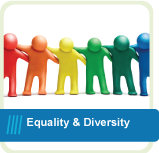Equality and Diversity
Key Message

 Understanding Equality and Diversity is vital if we
want to deliver person-centred, safe and effective care. Equality
is about creating a fairer society where everyone can participate
and have the opportunity to fulfil their potential and no one is
unfairly disadvantaged. Diversity is valuing peoples' differences
and addressing their different needs and situations.
Understanding Equality and Diversity is vital if we
want to deliver person-centred, safe and effective care. Equality
is about creating a fairer society where everyone can participate
and have the opportunity to fulfil their potential and no one is
unfairly disadvantaged. Diversity is valuing peoples' differences
and addressing their different needs and situations.
Delivering on equality and diversity in the health service means that we are tackling barriers which may prevent some groups of people from accessing services. It also means that we are delivering services which meet the diverse needs of our patients, service users and carers. Good equality and diversity practice:
- ensures that everyone is treated with dignity and respect
- supports involvement and self-management and supports improved outcomes for all.
Equality and diversity are not 'add-ons', but should be an essential part of how we deliver our services and how we work together.
What does this mean for the Effective Practitioner?
All staff play a vital role in delivering a service which promotes equality and diversity. The Practitioner must be able to:
- Recognise discrimination and identify risks of discrimination - whether direct discrimination, indirect discrimination or harassment;
- Understand the potential consequences of discrimination;
- Be able to identify and respond to the specific needs of diverse patients, service users and carers which arise from their personal, social or cultural background;
- Be accountable for providing a service which demonstrates good equality and diversity practice; and
- Support the empowerment of patients, service users and their carers so that they may be involved in their own care and health improvement.
Good equality and diversity practice involves:
- Communicating with patients, service users and carers in a way that is accessible to them;
- Making reasonable adjustments in the way we do our work and deliver our services to take account of the particular needs of disabled people;
- Understanding the role that cultural and religious beliefs play in health care and peoples' experiences of the health service;
- Ensuring that everyone gets care which takes account of their individual needs;
- Treating everyone with dignity and respect at all times.
![]() You can download a copy of
the Equality and
Diversity learning activities.
You can download a copy of
the Equality and
Diversity learning activities.
Reflection
Remember, recording your reflections is an important part of the learning process. Take time to structure your thoughts, feelings and any future actions on one the forms available in the Reflective Practice section. Click here to visit the page.
In your reflections you could also consider how your learning relates to the Facilitation of Learning, Leadership and Evidence, Research and Development pillars of practice.
Return to topSupplementary Resources
![]() Equality and Diversity: Introduction
podcast
Equality and Diversity: Introduction
podcast
![]() Equality and Diversity: Examples of
Inequalities podcast
Equality and Diversity: Examples of
Inequalities podcast
![]() Equality and Diversity:
Inequalities in Access, Process & Outcomes podcast
Equality and Diversity:
Inequalities in Access, Process & Outcomes podcast
![]() View a full range of supplementary
resources
View a full range of supplementary
resources

